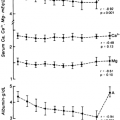ACTIONS OF PARATHYROID HORMONE
Part of “CHAPTER 51 – PARATHYROID HORMONE“
PARATHYROID HORMONE FUNCTIONS
The major function of PTH appears to be the maintenance of a normal level of extracellular fluid calcium. The hormone exerts important effects on bone and kidney and indirectly influences the gastrointestinal tract. In response to a fall in the extracellular fluid ionized calcium concentration, PTH is released from the parathyroid cell and acts directly on the kidney to enhance renal calcium reabsorption and promote the conversion of 25-hydroxy-vitamin D to 1,25-dihydroxyvitamin D.92 This latter metabolite increases gastrointestinal absorption of calcium and, with PTH, induces skeletal resorption, causing the restoration of extracellular fluid calcium and the neutralization of the signal initiating PTH release. The opposite series of homeostatic events occurs in response to a rise in extracellular fluid calcium levels.
Although this scheme outlines the overall events that occur after a fall in calcium levels, aspects of the response may vary with the extent of the fall in calcium concentration and the consequent rise in PTH. There is some evidence that the actions of PTH on target tissues may depend on its prevailing concentration.93 Consequently, certain actions of PTH, such as renal calcium retention and even skeletal anabolic actions, may predominate at relatively low circulating concentrations of PTH, but skeletal lysis may become evident only at higher levels of circulating PTH.
In addition to regulating calcium homeostasis, PTH elicits various other responses. Whether these other functions evolved independently or to complement the role of the hormone in maintaining calcium homeostasis is unclear. Among these other responses are perturbations of other ions, the most marked of which are those involving phosphate. As a consequence of PTH-enhanced 1,25-dihydroxyvitamin D production, the gastrointestinal absorption of phosphate is facilitated to some extent, and with PTH-induced skeletal lysis, phosphate and calcium are released. These effects increase the extracellular fluid phosphate levels, but the predominant effect of PTH on phosphate homeostasis is to inhibit renal phosphate reabsorption and produce phosphaturia. Consequently, a net decrease in
extracellular fluid phosphate concentration occurs, and this may be viewed as adjunctive to the role of PTH in raising calcium levels.
extracellular fluid phosphate concentration occurs, and this may be viewed as adjunctive to the role of PTH in raising calcium levels.
In common with other peptide hormones, PTH interacts through a receptor on the outer surface of the plasma membrane of target cells. In these target tissues, the result of this interaction of PTH with the membrane receptor has classically been appreciated to be the stimulation of the enzyme adenylate cyclase on the inner surface of the plasma membrane, although the same receptor can couple to phosphatidylinositol turnover as well. The product of this adenylate cyclase activity, cellular cAMP, and the products of phospholipase activity, IP3, diacyl-glycerol, and intracellular Ca2+, initiate a cascade of events leading to the final cellular response to the hormone. The PTH receptor may activate both these intracellular signaling path-ways in some target tissues and act preferentially by means of one or another pathway in other cells, but these issues are still under study.
STRUCTURE OF PARATHYROID HORMONE CORRELATED WITH FUNCTION
The amino acid sequences of the major glandular form of mammalian PTH, PTH 1–84, have now been determined in humans, cattle, pigs, dogs, and rats (Fig. 51-5).11,20 The corresponding amino acid sequence of the chicken peptide has also been determined and contains 88 rather than 84 amino acids. Studies correlating hormonal structure and function have emphasized the importance of the NH2-terminal region to bioactivity. Considerable deletion of the middle and COOH-terminal region of the intact peptide can be tolerated without apparent loss of biologic activity. A peptide composed of the NH2-terminal 34 residues, PTH 1–34, appears to contain all of the conventional bioactivity of the intact hormone when tested in various bioassay systems.94 Synthetic NH2-terminal fragments of PTHrP, which share a high degree of homology with PTH within the NH2-terminal 13 residues, have been shown to mimic PTH actions in many bioassay systems.95,96 and 97
Stay updated, free articles. Join our Telegram channel

Full access? Get Clinical Tree





